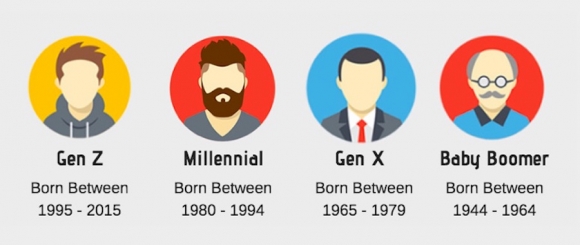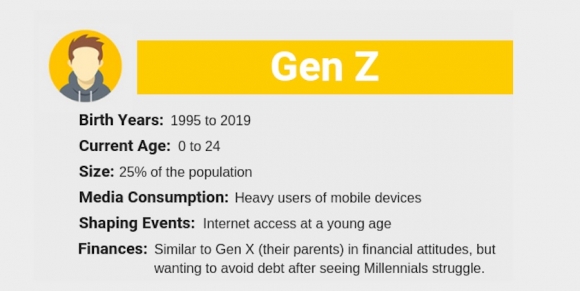Articles and News
Get Ready for Gen Z, The Next Generation of Buyers | April 29, 2020 (0 comments)

Merrick, NY—Generation Z is the most recent generation of consumers. Born between 1995 and 2015, they are presently between four and 24 years old, approximately 74 million in the United States. Some nicknames for this cohort include i-Generation, Post-Millennials, and the Homeland generation. They’re the offspring of Gen-X group (born between 1965-1979, currently between 40-54 years old) and differ from their parents’ product buying habits. Image at left: BCDTravel.com
Most Gen-Z’ers grew up occupying themselves with their parents’ mobile phones or tablets, like my own children did, and received their first mobile phone at around 10 years old. They have grown up in a connected world, with their smartphones as their favorite form of interaction. Generation Z will not remember a time where they did not have access to the Internet to enjoy spending time surfing the net, texting and chatting with friends. They look for appealing interactions involving brand/product relationships along with peer recognition. Generation Z need to be engaged and they look to peers when making decisions and apply information readily available in making their decisions on buying products. My 17-year-old, always before requesting or buying a product, looks on YouTube to read reviews and see what others thought about the product. Her latest form of decision-making includes TikTok,the destination for short-form mobile videos. Their mission is to capture and present the world's creativity, knowledge, and precious life moments, directly from the mobile phone. TikTok “enables everyone to be a creator and encourages users to share their passion and creative expression through their videos.”
This is a generation of why, how, what, when regarding product questions. As a retailer, answering them with “because I know,” “believe me,” or “I am saying so,” is gone. Because Generation Z is growing up in an information-filled society, as a retailer you will need to have your facts and figures correct and your content readily available.

The four main consumer cohorts today. Image: Kasasa.com
Why? Because they will expect you to have all their consumer-service questions answered. They will then either fact-check you, or if you don’t have their answers, they will find it themselves. This could lead them to find what they’re looking for with another competitor who does have their answers readily available. They want personalized and interactive purchasing experiences, and they want those experiences to show the latest digital content and to shop with products that allow them to interact with the business.
Generation Z prefers collaborative engagement.Collaborative engagementis an integrated communications approach that leverages information and knowledge to support individual ‘buy-in’ and ownership. As explained in the JewelryEcomm.com episode with Mike Hauben, Marketing Strategies for Jewelers During the Outbreak, consumer monitoring, evaluation reporting, are essential for success, and product use, especially for this generation. Ease and speed of navigating a website or an app while researching purchases or shopping is important. Creating content, photos, video, blogging, posting, promoting on-line traffic is essential for this fact filled generation know your analytics, and research.
Each generation grows up in different financial climates, says the website Kasasa.com. This informs their financial attitudes, opinions on buying, and they begin to develop personal finance habits. For Gen-Z, some of their financial habits are more in line with older generations than with their Millennial siblings, Gen-X parents, or Boomer grandparents.
Kasasa explains, “They have been a part of the ups and downs of their parents’ (Gen X) finances along with seeing the struggles of Millennials to start their incomes, and have taken on a more fiscally conservative outlook. They want to avoid debt and appreciate products and services that help them with this approach.” Although they prefer to avoid debt like their Depression-era great-grandparents, Gen-Z fully embraces financial technology like debit cards and mobile banking.
They do not necessarily need the brand name of a product, but they expect the service behind it. My daughter asserts that if she and her friends are going to buy name brands, they expect better service. The ability to try products and have easy returns also is very important.

Key characteristics of the Gen-Z cohort. Image: Kasasa.com
In buying jewelry, they first see jewelry as an accessory to emphasize style and personal brand. Currently through collaborative engagement what is trending in jewelry is the layering of bracelets, necklaces and multiple earrings. They see jewelry not for status but as style first. If they are going to own something valuable in jewelry, they rather have one good piece and it be real and of good quality. In buying, product sustainability does play a key role. Once they are intrigued with buying the product, they look to see what else the product does: if it does good for others and the environment it will be a more positive buying experience.
Generation Z buying habits are distinctive from previous generations’ with their necessity to observe Instagram, TikTok, blogging, posting, and endorsements. They require creative content with photos, videos, visuals, and information provided needs to be accurate in contact, store hours, and location. They read reviews and positive press is important. Another important factor is the ease of the company website, if they can’t get what they are looking for within 30 seconds, they stop.
This generation is responsible for 40% of consumer shopping, says Khoros.com. Here are some more Gen-Z statistics, its article titled 5 Generation Z Statistics on Spending Habits That Marketers Need to Know, by Jaime Netzer:
- 47% of U.S. Gen Z consumers research items on mobile devices while shopping at brick and-mortar locations.
- 60% of Gen Z folks are more likely than average consumers to hang up if their call isn’t answered in under 45 seconds.
- 42% percent of Gen Z respondents in a recent study said they would participate in an online game for a campaign; 43% would write a product review.
- 60% of Gen Z shoppers won’t use apps or websites that load slowly or are difficult to navigate.
- 63% of Gen Z members prefer real people to celebrities when it comes to advertisements.
Separately, a recent MVI Marketing study, interviewing Gen-Z consumers since the start of the coronavirus pandemic, shows a deep appreciation for their family, friends, loved ones, and other social bonds. MVI CEO Martin Hurwitz says the experience of isolation may spur an increase in engagements and marriages, with jewelry filling its traditional role of an emotional gift, but he warns that’s where tradition ends. Today’s couples are highly diverse: biracial, same-gender, non-English-speaking, etc., and the jewelry they buy to mark the milestone may not be diamonds or other expensive status pieces, but rather affordably priced unique and meaningful items.
Read the full MVI study here.
If retailers want to attract the attention of the continually on top of trends, information filled, mobile focused Generation Z and have them as loyal consumers, they will need to provide interactive and personalized experiences that are current with the latest digital developments. Retailers must be technically knowledgeable and if they want to reach generation Z, they need to be online and easily accessible.







